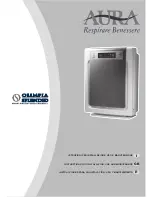
Diagnostics
RT-SVX34F-EN
107
If the “Fan Failure” switch opens for at least 40 seconds
during fan operation (indicating a fan failure) the unit will
stop.
RTRM Zone Sensor Module (ZSM) Tests
Note:
These procedures are not for programmable or
digital models and are conducted with the Zone
Sensor Module electrically removed from the
system.
Test 1: Zone Temperature Thermistor (ZTEMP)
This component is tested by measuring the resistance
between terminals 1 and 2 on the Zone Temperature
Sensor. The following are some typical indoor
temperatures, and corresponding resistive values.
Test 2: Cooling Set Point (CSP) and Heating
Set Point (HSP)
The resistance of these potentiometers are measured
between the following ZSM terminals. Refer to the chart
above for approximate resistances at the given set points.
CSP = Terminals 2 and 3
Range = 100 to 900 Ohms approximate
HSP = Terminals 2 and 5
Range = 100 to 900 Ohms approximate
Test 3: System Mode and Fan Selection
The combined resistance of the Mode selection switch and
the Fan selection switch can be measured between
terminals 2 and 4 on the ZSM. The possible switch
combinations are listed below with their corresponding
resistance values.
Test 4: LED Indicator Test (SYS ON, HEAT,
COOL & SERVICE).
Method 1
Testing the LED using a meter with diode test function. Test
both forward and reverse bias. Forward bias should
measure a voltage drop of 1.5 to 2.5 volts, depending on
your meter. Reverse bias will show an Over Load, or open
circuit indication if LED is functional.
Method 2
Testing the LED with an analog Ohmmeter. Connect
Ohmmeter across LED in one direction, then reverse the
leads for the opposite direction. The LED should have at
least 100 times more resistance in reverse direction, as
compared with the forward direction. If high resistance in
both directions, LED is open. If low in both directions, LED
is shorted.
Method 3
To test LED's with ZSM connected to the unit, test voltages
at LED terminals on ZSM. A measurement of 32 Vdc,
across an unlit LED, means the LED has failed.
Note:
Measurements should be made from LED common
(ZSM terminal 6 to respective LED terminal). Refer
to the Zone Sensor Module (ZSM) Terminal
Identification table at the beginning of this section.
Programmable & Digital Zone Sensor
Test
Testing serial communication voltage
1.
Verify 24 VAC is present between terminals RTRM J6-
14 and RTRM J6-11.
2. Disconnect wires from RTRM J6-11 and RTRM J6-12.
Measure the voltage between RTRM J6-11 and RTRM
J6-12; it should be approximately 32 Vdc.
3. Reconnect wires to terminals RTRM J6-11 and RTRM
J6-12. Measure voltage again between RTRM J6-11
and RTRM J6-12, voltage should flash high and low
Table 78. Zone Sensor Module (ZSM) terminal
identification (constant volume only)
Terminal
# Terminal
I.D.
Terminal
# Terminal
I.D.
J6-1
ZTEMP J6-6
LED
COMMON
J6-2
SIGNAL
COMMON
J6-7
HEAT LED
J6-3
CSP* J6-8
COOL
LED
J6-4
MODE
J6-9
SYS ON LED
J6-5
HSP J6-10
SERVICE
LED
Table 79. Resistance values
Zone or Set Point
Temperature
Nominal ZTEMP
Resistance
Nominal CSP or
HSP Resistance
50° F
19.9 K-Ohms
889 Ohms
55° F
17.47 K-Ohms
812 Ohms
60° F
15.3 K-Ohms
695 Ohms
65° F
13.49 K-Ohms
597 Ohms
70° F
11.9 K-Ohms
500 Ohms
75° F
10.50 K-Ohms
403 Ohms
80° F
9.3 K-Ohms
305 Ohms
85° F
8.25 K-Ohms
208 Ohms
90° F
7.3 K-Ohms
110 Ohms
Table 80. Nominal resistance
VAV System
Switch
CV System
Switch
CV Fan
Switch
Nominal
Resistance
OFF
OFF AUTO
2.3
K-Ohms
COOL AUTO
4.9
K-Ohms
AUTO
AUTO AUTO
7.7
K-Ohms
OFF ON 11.0
K-Ohms
COOL ON 13.0
K-Ohms
AUTO ON 16.0
K-Ohms
HEAT AUTO
19.0
K-Ohms
HEAT ON 28.0
K-Ohms
















































